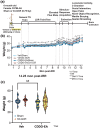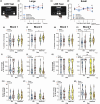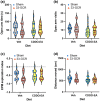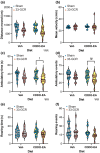The longitudinal behavioral effects of acute exposure to galactic cosmic radiation in female C57BL/6J mice: Implications for deep space missions, female crews, and potential antioxidant countermeasures
- PMID: 39318241
- PMCID: PMC11658192
- DOI: 10.1111/jnc.16225
The longitudinal behavioral effects of acute exposure to galactic cosmic radiation in female C57BL/6J mice: Implications for deep space missions, female crews, and potential antioxidant countermeasures
Abstract
Galactic cosmic radiation (GCR) is an unavoidable risk to astronauts that may affect mission success. Male rodents exposed to 33-beam-GCR (33-GCR) show short-term cognitive deficits but reports on female rodents and long-term assessment are lacking. We asked: What are the longitudinal behavioral effects of 33-GCR on female mice? Also, can an antioxidant/anti-inflammatory compound (CDDO-EA) mitigate the impact of 33-GCR? Mature (6-month-old) C57BL/6J female mice received CDDO-EA (400 μg/g of food) or a control diet (vehicle, Veh) for 5 days and Sham-irradiation (IRR) or whole-body 33-GCR (0.75Gy) on the 4th day. Three-months post-IRR, mice underwent two touchscreen-platform tests: (1) location discrimination reversal (tests behavior pattern separation and cognitive flexibility, abilities reliant on the dentate gyrus) and (2) stimulus-response learning/extinction. Mice then underwent arena-based behavior tests (e.g. open field, 3-chamber social interaction). At the experiment's end (14.25-month post-IRR), an index relevant to neurogenesis was quantified (doublecortin-immunoreactive [DCX+] dentate gyrus immature neurons). Female mice exposed to Veh/Sham vs. Veh/33-GCR had similar pattern separation (% correct to 1st reversal). There were two effects of diet: CDDO-EA/Sham and CDDO-EA/33-GCR mice had better pattern separation vs. their respective control groups (Veh/Sham, Veh/33-GCR), and CDDO-EA/33-GCR mice had better cognitive flexibility (reversal number) vs. Veh/33-GCR mice. One radiation effect/CDDO-EA countereffect also emerged: Veh/33-GCR mice had slower stimulus-response learning (days to completion) vs. all other groups, including CDDO-EA/33-GCR mice. In general, all mice showed normal anxiety-like behavior, exploration, and habituation to novel environments. There was also a change relevant to neurogenesis: Veh/33-GCR mice had fewer DCX+ dentate gyrus immature neurons vs. Veh/Sham mice. Our study implies space radiation is a risk to a female crew's longitudinal mission-relevant cognitive processes and CDDO-EA is a potential dietary countermeasure for space-radiation CNS risks.
Keywords: CDDO‐EA; Mars‐relevant; arena‐based classical rodent behavioral tests; hippocampus; space radiation; touchscreen operant behavior.
© 2024 The Author(s). Journal of Neurochemistry published by John Wiley & Sons Ltd on behalf of International Society for Neurochemistry.
Conflict of interest statement
The authors have no conflict of interests to declare.
Figures













Update of
-
The longitudinal behavioral effects of acute exposure to galactic cosmic radiation in female C57BL/6J mice: implications for deep space missions, female crews, and potential antioxidant countermeasures.bioRxiv [Preprint]. 2024 Apr 15:2024.04.12.588768. doi: 10.1101/2024.04.12.588768. bioRxiv. 2024. Update in: J Neurochem. 2025 Jan;169(1):e16225. doi: 10.1111/jnc.16225. PMID: 38659963 Free PMC article. Updated. Preprint.
Similar articles
-
The longitudinal behavioral effects of acute exposure to galactic cosmic radiation in female C57BL/6J mice: implications for deep space missions, female crews, and potential antioxidant countermeasures.bioRxiv [Preprint]. 2024 Apr 15:2024.04.12.588768. doi: 10.1101/2024.04.12.588768. bioRxiv. 2024. Update in: J Neurochem. 2025 Jan;169(1):e16225. doi: 10.1111/jnc.16225. PMID: 38659963 Free PMC article. Updated. Preprint.
-
Effects of a 33-ion sequential beam galactic cosmic ray analog on male mouse behavior and evaluation of CDDO-EA as a radiation countermeasure.Behav Brain Res. 2022 Feb 15;419:113677. doi: 10.1016/j.bbr.2021.113677. Epub 2021 Nov 21. Behav Brain Res. 2022. PMID: 34818568 Free PMC article.
-
Beyond Earth's shield: The surprising way antioxidants could pave the road to Mars.J Neurochem. 2025 Jan;169(1):e16233. doi: 10.1111/jnc.16233. Epub 2024 Oct 10. J Neurochem. 2025. PMID: 39387706
-
Microglia: Ally and Enemy in Deep Space.Neurosci Biobehav Rev. 2021 Jul;126:509-514. doi: 10.1016/j.neubiorev.2021.03.036. Epub 2021 Apr 16. Neurosci Biobehav Rev. 2021. PMID: 33862064 Review.
-
Getting ready for the manned mission to Mars: the astronauts' risk from space radiation.Naturwissenschaften. 2007 Jul;94(7):517-26. doi: 10.1007/s00114-006-0204-0. Epub 2007 Jan 19. Naturwissenschaften. 2007. PMID: 17235598 Review.
Cited by
-
Thymus ad astra, or spaceflight-induced thymic involution.Front Immunol. 2025 Jan 24;15:1534444. doi: 10.3389/fimmu.2024.1534444. eCollection 2024. Front Immunol. 2025. PMID: 39926601 Free PMC article. Review.
References
-
- Alaghband, Y. , Klein, P. M. , Kramár, E. A. , Cranston, M. N. , Perry, B. C. , Shelerud, L. M. , Kane, A. E. , Doan, N. L. , Ru, N. , Acharya, M. M. , Wood, M. A. , Sinclair, D. A. , Dickstein, D. L. , Soltesz, I. , Limoli, C. L. , & Baulch, J. E. (2023). Galactic cosmic radiation exposure causes multifaceted neurocognitive impairments. Cellular and Molecular Life Sciences, 80, 29. - PMC - PubMed
-
- Allen, A. R. , Raber, J. , Chakraborti, A. , Sharma, S. , & Fike, J. R. (2015). 56Fe irradiation alters spine density and dendritic complexity in the mouse hippocampus. Radiation Research, 184, 586–594. - PubMed
-
- Bellone, J. A. , Rudobeck, E. , Hartman, R. E. , Szücs, A. , & Vlkolinský, R. (2015). A single low dose of proton radiation induces long‐term behavioral and electrophysiological changes in mice. Radiation Research, 184, 193–202. - PubMed
-
- Blackwell, A. A. , Fesshaye, A. , Tidmore, A. I. , Lake, R. , Wallace, D. G. , & Britten, R. A. (2022). Rapid loss of fine motor skills after low dose space radiation exposure. Behavioural Brain Research, 430, 113907. - PubMed
MeSH terms
Substances
Grants and funding
- R25 GM071745/GM/NIGMS NIH HHS/United States
- R01 DA016765/DA/NIDA NIH HHS/United States
- R01 MH129970/MH/NIMH NIH HHS/United States
- NASA/NASA/United States
- T32 NS007413/NS/NINDS NIH HHS/United States
- RF1 NS088555/NS/NINDS NIH HHS/United States
- R01 NS126279/NS/NINDS NIH HHS/United States
- R15 MH117628/MH/NIMH NIH HHS/United States
- T32 DA007290/DA/NIDA NIH HHS/United States
- T32 MH076690/MH/NIMH NIH HHS/United States
- R56 NS126279/NS/NINDS NIH HHS/United States
- R01 NS088555/NS/NINDS NIH HHS/United States
- NH/NIH HHS/United States
- R01 DK135871/DK/NIDDK NIH HHS/United States
- R21 MH107945/MH/NIMH NIH HHS/United States
- K02 DA023555/DA/NIDA NIH HHS/United States
LinkOut - more resources
Full Text Sources
Medical
Miscellaneous

